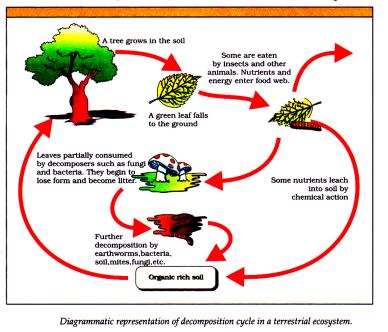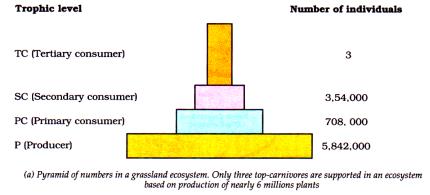- Functional unit of nature where living organisms interact among themselves and with surrounding environment.
- Its divided into terrestrial (forest, grassland and desert) and aquatic (pond, lake, wetland, river, estuary).
- Man-made ecosystem: Crop fields and aquarium.
Ecosystem- Structure and Function:
Basic requirement is constant solar input.
- Stratification: Vertical distribution of different species occupying different levels.
eg. trees occupy top strata, shrubs second and herbs and grasses lowest level.
- Basic functions of ecosystem: Productivity, decomposition, energy flow, nutrient cycling.
- Structure of ecosystem involves composition of community in terms of biomass, population and availability and distribution of non living factors-nutrient, water.
- Ecosystem has 2 components - Abiotic (non living) and biotic (living)
- 2 main processes occur in ecosystem - continuous flow of nutrients, continuous input and flow of energy.
Aquatic ecosystem –a pond:
Self sustaining system.
- Abiotic components - water, soil.
- Autotrophs (phytoplankton, algae, some plants) prepare their own food. These are consumed by heterotrophs (zooplankton).
- When algae and fish die, decomposers (fungi and bacteria) decay them and release them back to water.
- So, there is unidirectional energy flow towards higher trophic level and dissipation of heat occurs.
Productivity: Rate of biomass production, in terms of gm-2yr-1 or (Kcalm-2) yr-1.
- Primary Production: Amount of biomass/organic matter produced per unit area over a time period during photosynthesis. Gross primary Productivity(NPP): Rate of production of organic matter during photosynthesis. Some of it is utilised in respiration.
b. Net primary productivity(NPP):Biomass available for heterotroph consumption.
i.e. Gross primary productivity - respiration loss (R) = NPP.
- Primary productivity depends on environmental factors, nutrients available and photosynthetic capacity.
- Annual NPP of whole biosphere is approximately 170 billion tons of organic matter. Oceans occupy 70% surface but productivity is 55 billion tons.
2. Secondary productivity: Rate of formation of new organic matter by consumers.
- Decomposition: Breakdown of complex organic matter to inorganic substances (CO2, nutrients, water) by decomposers.
- Detritus:- Dead plant remains (leaves, flower) and animal remains, raw material for decomposition Important steps are:
(i) Fragmentation: Breakdown of detritus into small particles by detrivores (earthworm).
(ii) Leaching: Water soluble inorganic nutrients go down into soil and get precipitated as salts.
(iii) Catabolism: Bacterial and fungal enzyme degrade detritus to simple inorganic substances. These three processes operate simultaneously.
(iv) Humification: Accumulation of dark coloured amorphous substance - humus that is resistant to microbes, undergo decomposition at slow rate and reservoir of nutrients as it is colloidal.
(v) Mineralisation: Degradation of humus by microbes and release of inorganic nutrients.
- Its an oxygen requiring process and depends on composition of detritus and climatic factors.
- Rate is slower if detritus is rich in lignin and chitin or if temperature is low and O2 isn’t available whereas faster if detritus is rich in nitrogen and sugars or if temperature is high and O2 is available.

Energy flow:
- Sun is the only source of energy on Earth except deep sea hydro-thermal ecosystem.
- Only 50% of sun’s radiation is photosynthetically active radiation (PAR). Plants capture only 2-10% PAR.
- There is unidirectional energy flow from sun to producer and to consumer.
- Ecosystem don’t follow second law of thermodynamics, as they need constant energy supply to synthesise molecules.
- Producers: Green plants, terrestrial ecosystem-herbaceous and woody plants, aquatic ecosystem-phytoplankton, algae.
- Consumers: Animals depending directly or indirectly on plants for food.
- ®Primary Consumers (heterotrophs): Feed on producers. eg. insect, birds and mammal in terrestrial ecosystem; molluscs in aquatic ecosystem.
- ®Secondary Consumers: Feed on animals which eat plants.
- Primary carnivores: Consumers that feed on herbivores, also secondary consumers.
- Secondary carnivores: Depend on primary carnivores for food.
Food Chain:
Interdependency of organisms.
1. Grazing Food Chain (GFC): Main channel for energy flow in aquatic ecosystem.
eg. Grass ® Deer ® Jackal ® Lion
(producer) (primary (secondary (tertiary)
consumer) consumer) consumer
2. Detritus Food Chain (DFC): Main channel for energy flow in terrestrial ecosystem.
- Primary energy source-dead organic matter.
- Decomposers (heterotrophic) or saprophyte meet their energy requirement by degrading detritus into simple, inorganic matter by digestive enzymes.
- GFC and DFC are connected, as when organism of GFC die, it enters DFC and also some animals of DFC are prey to GFC. This interconnection of food chains make food web.
Trophic level: Organism occupy specific place in ecosystem depending upon the source of food and nutrition. Producers belong to first trophic level.
- Amount of energy decreases at successive trophic levels. Organisms fulfill their energy requirement from organisms at lower trophic level.
- Standing crop: Mass of living material each trophic level has (biomass in a unit area), expressed either as fresh or dry weight.
- 10% energy law: Only 10% of energy is transferred from 1 level to another. So, no. of levels in GFC are restricted.


Ecological pyramid:
Graphical representation of no. of individuals/ amount of biomass/ amount of energy at different trophic levels in ecosystem.
- Base: Producer (1st trophic level); top - tertiary/top level consumers.
- All organisms have to be considered to calculate energy.
- A given organism can simultaneously occupy more than 1 trophic level in same ecosystem.
eg. bird is primary consumer when eats seeds, fruits but secondary consumer when eats insects and worms.
- In most ecosystem, pyramid of number, energy and biomass are upright i.e. producers are more in no and biomass than herbivores and herbivores are more in no. and biomass than carnivores, pyramid of energy is always upright as some energy is lost at each step.
- Pyramid of biomass in sea- ‘inverted’ as biomass of fish exceeds that of phytoplankton.
- Pyramid of energy: Amount of energy at each level in given time per unit area.



Limitations:
Considers simple food chain (which never exists in nature) and doesn’t take into account those species which occur at more than 1 trophic level.
(ii) Doesn’t take into account decomposers or saprophytes, which play an important role.
- Ecological Succession: Gradual and fairly predictable change in species composition in a given area. Some species may increase while some may decline or disappear.
- Composition and structure of communities orderly and sequentially change with change in environment. This leads to community which is near equilibrium with environment - climax community. eg. in succession from pond to forest, climax community is forest.
- Sere: Sequence of communities that replace one another in a given area. Each transitional community is seral community/seral stage.
- In successive seral stage, there is increase in diversity of plant and animal species along with increase in species and biomass.
- Primary succession: In area where no life ever existed. Takes a long time as soil is required for creation of new communities and soil formation takes 100 to 1000 years eg. bare rock, new lava, new pond.
- Secondary succession: In area where life ever existed but wiped out due to some reasons, takes less time as some soil is present. eg. abandoned farm land, cut forests, flooded land.
- During succession, man made or natural disturbance can convert a seral stage to earlier one.
Succession of plants:
- Pioneer species: Species that invade a bare area.
1. Hydrarch succession: In wet areas, from hydric (too wet) to mesic (moderate water) condition.
2. Xerarch succession: In dry area, from xeric (too dry) to mesic (moderate water) condition.
- Primary succession on rocks: Pioneer species is lichen which secrete acids to dissolve rocks and help in weathering and soil formation, which paves way to small bryophytes (take hold in small amount of soil), then to higher plants. So, habitat changed from xerophytic to mesophytic. This climax community remains stable as long as environment remains unchanged.
- Primary succession on water: Phytoplanktons are pioneer, which are replaced by root submerged plants, then floating angiosperms, then free floating plants, reed swamp, marsh meadow, scrub and then trees. Hence, water body converts to land, climax is again forest.
- In secondary succession, species invading depends on soil condition, water and environment.

Nutrient Cycling/Biogeochemical cycles:
Movement of nutrients through various components of ecosystem.
- Its of 2 types - gaseous and sedimentary.
- Standing state: Amount of nutrients present in the soil at any given time.
- Factors like soil, moisture, pH, temperature regulate rate of release of nutrients.
Gaseous:
ego nitrogen and carbon cycle, main reservoir is atmosphere.

- 71% carbon is found dissolved in oceans, 49% dry weight in organisms is carbon and fossil fuels are its reservoir.
- Oceans regulate CO2 in atmosphere.
- Occurs through atmosphere, ocean, living and dead organisms.
- 4 x 1013 Kg carbon is fixed by photosynthesis annually, same returns to atmosphere as CO2 through respiration.
- Decomposers release CO2 by degrading dead organic matter, also burning wood, forest fire, combustion of fossil fuel, volcanic activity, deforestation and transport increase of CO2 in atmosphere. Some amount of fixed carbon is lost to sediments.
2. Sedimentary
eg. Sulphur and phosphorus, main reservoir is in Earth’s crust.
Phosphorus Cycle: Constituent of membrane, nucleic acid, teeth, bones, energy transfer system.
- Natural reservoir - rocks (in form of phosphates).
- Small amount of phosphates dissolve in soil and absorbed by plants which pass on to animals when they consume plants. When animals die, phosphate solubilising bacteria act and release phosphorus in soil.

Major difference in Carbon and phosphorus cycle:
(i) Atmospheric input of phosphorus through rainfall are much smaller than carbon.
(ii) Gaseous exchange of phosphorus between organism and environment are negligible.
Ecosystem Services: Products and services provided by healthy and functioning ecosystem. eg. fruits, pure drinking water, spices, fibres, medicinal plants, generate fertile soils, help in nutrient cycling, pollination, mitigating flood and drought etc.
- Robert Costanzia tried to assess value of different ecosystem which are taken for granted as available freely.
- Researchers have found that average value of ecosystem - $ 33 trillion a year which is twice global gross national product i.e. $ 18 trillion.
- Out of this cost, 50% account for soil formation, less than 10% each by recreation and nutrient cycling and 6% each for climate regulation and wildlife habitat.


… [Trackback]
[…] There you will find 7940 additional Info on that Topic: eklabhyaclasses.com/blog/ecosystem/ […]
… [Trackback]
[…] Here you can find 59838 additional Info on that Topic: eklabhyaclasses.com/blog/ecosystem/ […]
… [Trackback]
[…] Read More Info here to that Topic: eklabhyaclasses.com/blog/ecosystem/ […]
… [Trackback]
[…] Read More on that Topic: eklabhyaclasses.com/blog/ecosystem/ […]
… [Trackback]
[…] There you will find 97320 additional Information to that Topic: eklabhyaclasses.com/blog/ecosystem/ […]
… [Trackback]
[…] Here you will find 72317 additional Information to that Topic: eklabhyaclasses.com/blog/ecosystem/ […]
… [Trackback]
[…] Find More here to that Topic: eklabhyaclasses.com/blog/ecosystem/ […]
… [Trackback]
[…] Find More on on that Topic: eklabhyaclasses.com/blog/ecosystem/ […]